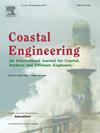垂直桩上破浪力的群体相互作用效应:实验测试和预测模型
IF 4.2
2区 工程技术
Q1 ENGINEERING, CIVIL
引用次数: 0
摘要
桩群被广泛用作桥梁、防波堤和采油平台等许多海岸结构的支撑。本文利用实验测试和基于机器学习的预测建模,探讨了如何理解桩群内部的相互作用效应并预测桩群的破浪力。以往对这一重要工程问题的研究存在局限性,即考虑的桩群布置有限。因此,只能针对特定的桩群布置开发预测方法,而没有考虑入射波方向的影响。在本研究中,为了部分克服这一局限性,我们在六种破浪条件下对 70 种不同的桩群布置进行了广泛的实验研究。为了全面评估桩群内部的相互作用效应,引入了以总力、准静力和动力为特征的三个桩群系数。首先,评估了三种基本布置(串联、并排和交错)的桩群系数。结果显示,串联布置有遮挡效应,并排布置有放大效应。然而,在交错布置中,测量桩上的力与孤立桩上的力相似,既没有观察到明显的遮挡效应,也没有观察到放大效应。然后,所有布置的结果都突出表明,在桩间距较小的情况下,波浪方向对桩群系数有显著影响。最后,我们采用了不同的机器学习算法来开发桩群系数预测模型。XGBoost 模型在预测总力系数和准静力系数方面表现出更高的准确性,而动态力系数由于其随机性,准确预测仍具有挑战性。本文章由计算机程序翻译,如有差异,请以英文原文为准。
Group interaction effect on breaking wave forces on a vertical pile: Experimental tests and predictive models
Pile groups are extensively utilized as supports for many coastal structures, such as bridges, jetties, and oil production platforms. The problem of understanding the interaction effects within pile groups and predicting the breaking wave forces on them is considered in this paper, using experimental tests and machine learning-based predictive modeling. The restriction of previous studies on this important engineering problem is that the pile group arrangements considered are limited. Prediction methods are therefore developed only for specific pile group arrangements and do not incorporate the effect of the incident wave direction. In this study, to partially overcome this limitation, an extensive experimental investigation is conducted on 70 different pile group arrangements under six breaking wave conditions. Three pile group coefficients, characterized by the total, quasi-static, and dynamic forces, are introduced for a thorough assessment of the interaction effects within the pile group. First, the pile group coefficients for three basic arrangements (tandem, side-by-side, and staggered) are evaluated. The results reveal a sheltering effect in the tandem arrangement and an amplification effect in the side-by-side arrangement. However, the forces on the measured pile in the staggered arrangement resemble those on the isolated pile, with neither significant sheltering nor amplification effects observed. Then, the results for all arrangements highlight the significant effect of wave direction on the pile group coefficients for small inter-pile spacing. Finally, different machine learning algorithms are adopted to develop predictive models for the group coefficients. The XGBoost model demonstrates superior accuracy for predicting the total and quasi-static force coefficients, while the dynamic force coefficient remains challenging to predict accurately due to its stochastic nature.
求助全文
通过发布文献求助,成功后即可免费获取论文全文。
去求助
来源期刊

Coastal Engineering
工程技术-工程:大洋
CiteScore
9.20
自引率
13.60%
发文量
0
审稿时长
3.5 months
期刊介绍:
Coastal Engineering is an international medium for coastal engineers and scientists. Combining practical applications with modern technological and scientific approaches, such as mathematical and numerical modelling, laboratory and field observations and experiments, it publishes fundamental studies as well as case studies on the following aspects of coastal, harbour and offshore engineering: waves, currents and sediment transport; coastal, estuarine and offshore morphology; technical and functional design of coastal and harbour structures; morphological and environmental impact of coastal, harbour and offshore structures.
 求助内容:
求助内容: 应助结果提醒方式:
应助结果提醒方式:


